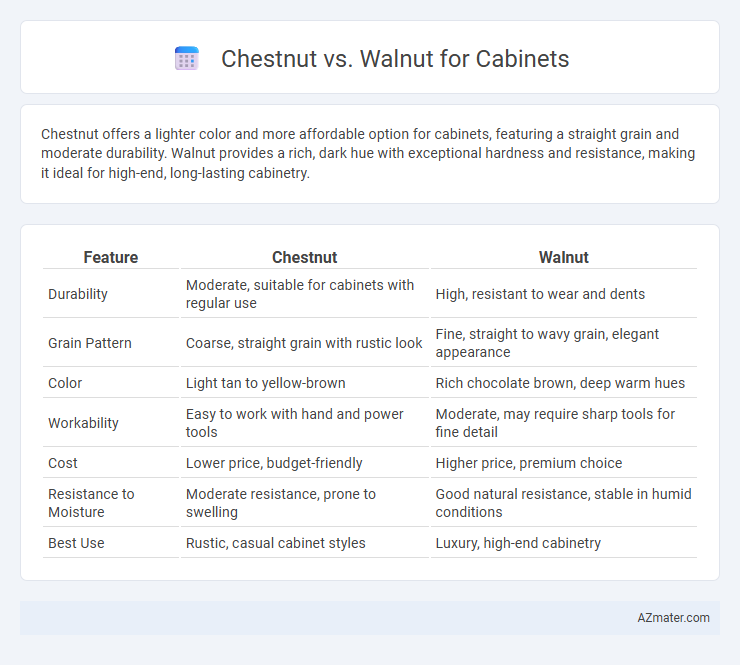Chestnut offers a lighter color and more affordable option for cabinets, featuring a straight grain and moderate durability. Walnut provides a rich, dark hue with exceptional hardness and resistance, making it ideal for high-end, long-lasting cabinetry.
Table of Comparison
| Feature | Chestnut | Walnut |
|---|---|---|
| Durability | Moderate, suitable for cabinets with regular use | High, resistant to wear and dents |
| Grain Pattern | Coarse, straight grain with rustic look | Fine, straight to wavy grain, elegant appearance |
| Color | Light tan to yellow-brown | Rich chocolate brown, deep warm hues |
| Workability | Easy to work with hand and power tools | Moderate, may require sharp tools for fine detail |
| Cost | Lower price, budget-friendly | Higher price, premium choice |
| Resistance to Moisture | Moderate resistance, prone to swelling | Good natural resistance, stable in humid conditions |
| Best Use | Rustic, casual cabinet styles | Luxury, high-end cabinetry |
Introduction to Chestnut and Walnut Cabinets
Chestnut cabinets offer a warm, rich grain pattern with a lighter, golden-brown hue that enhances traditional and rustic kitchen designs. Walnut cabinets are prized for their deep chocolate tones and smooth, consistent grain, providing a sophisticated and modern aesthetic. Both woods provide durability and longevity, but walnut tends to be denser and more expensive than chestnut, influencing cabinet choices based on style and budget.
Wood Characteristics: Chestnut vs Walnut
Chestnut wood features a lighter, warm beige to medium brown color with a coarse, straight grain and is known for its high durability and resistance to decay, making it ideal for cabinets requiring longevity and a traditional look. Walnut offers a rich, dark chocolate brown color with a fine, straight to wavy grain pattern, prized for its strength, smooth texture, and luxurious appearance, often used in high-end cabinetry. Both woods are hardwoods, but walnut is generally denser and heavier, contributing to its premium status and exceptional machinability in cabinet making.
Aesthetic Appeal and Color Variations
Chestnut wood offers warm, reddish-brown tones with a distinctive grain pattern that adds rustic charm and elegance to cabinets, making it ideal for traditional or country-style kitchens. Walnut provides rich, dark chocolate-brown hues with subtle purples and deep grains, delivering a luxurious, contemporary look that enhances modern cabinetry. Both woods feature natural color variations, but walnut's darker, more uniform shading allows for a sleek, sophisticated finish, while chestnut's lighter, varied tones contribute to a more casual, inviting atmosphere.
Durability and Hardness Comparison
Chestnut cabinets offer moderate durability with a Janka hardness rating around 1,000, making them softer and more prone to dents compared to walnut. Walnut features a superior Janka hardness of approximately 1,010 to 1,360, providing enhanced resistance to wear and impact, ideal for high-traffic kitchen environments. The denser grain structure of walnut contributes to its longevity and robust performance in cabinetry applications.
Cost Analysis: Chestnut vs Walnut Cabinets
Chestnut cabinets generally cost less than walnut cabinets due to the faster growth rate and wider availability of chestnut wood, making it a more budget-friendly option for kitchen renovations. Walnut, known for its rich, dark grain and durability, commands a higher price that reflects its luxury status and long-lasting quality. Choosing chestnut offers cost savings without compromising on aesthetic appeal, while walnut provides a premium finish ideal for high-end cabinetry projects.
Workability and Maintenance Requirements
Chestnut offers excellent workability due to its straight grain and medium hardness, making it easy to cut, shape, and sand for cabinetry projects. Walnut, although denser and slightly harder, provides a smooth finish but may require more effort during machining and carving. Both woods need regular maintenance to preserve their rich color and prevent drying; chestnut typically demands more frequent sealing to avoid moisture damage, while walnut benefits from periodic oiling to maintain its natural luster.
Environmental Impact and Sustainability
Chestnut cabinets offer a lower environmental impact due to the species' rapid growth rate and widespread availability, supporting sustainable forestry practices. Walnut, while prized for its rich color and durability, often has a higher environmental footprint because of slower growth and limited natural abundance, leading to increased harvesting pressure. Choosing chestnut contributes to reducing deforestation and promotes a more sustainable supply chain in cabinetry.
Popular Cabinet Styles for Each Wood
Chestnut cabinets often feature traditional and rustic styles, showcasing rich grain patterns and warm tones that complement farmhouse and colonial kitchen designs. Walnut cabinets excel in modern and contemporary styles, prized for their smooth texture and deep, dark hues that enhance sleek, minimalist aesthetics. Both woods offer durability, but chestnut emphasizes a cozy, vintage appeal while walnut provides a luxurious, refined look ideal for upscale cabinetry.
Pros and Cons of Chestnut Cabinets
Chestnut cabinets offer a warm, rich color with prominent grain patterns that enhance traditional and rustic kitchen designs, providing durability and resistance to wear. However, chestnut wood tends to be softer and less dense compared to walnut, making it more prone to dents and scratches over time. While chestnut is generally more affordable and environmentally sustainable, walnut cabinets boast greater hardness, deeper hues, and a more luxurious finish that may better suit high-end cabinetry.
Pros and Cons of Walnut Cabinets
Walnut cabinets offer a rich, dark brown color with intricate grain patterns, making them a popular choice for luxury kitchens and timeless elegance. They are highly durable and resistant to warping, but their higher cost and sensitivity to sunlight requiring occasional refinishing can be drawbacks. Compared to chestnut, walnut's deeper tones complement modern and traditional styles, though it may darken rooms with limited natural light.

Infographic: Chestnut vs Walnut for Cabinet
 azmater.com
azmater.com